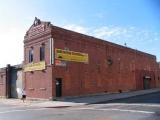News Releases from Region 02
EPA Announces Plan to Preserve and Reconstruct Gowanus Station's Historic Features
Engagement of the Gowanus Community Critical to the Cleanup of Gowanus Canal Superfund Site
(New York, N.Y.) The U.S. Environmental Protection Agency (EPA) today announced an agreement to carefully preserve historic features of the 234 Butler Street building, a local landmark important to the Gowanus community, including two portions of the building walls. The plan calls for dismantling, reconstruction and incorporation of these walls and historic features into the above-ground structure that will be part of the underground sewage capture tank to be built at the site. This agreement is an important step in the Agency’s efforts to clean up the Gowanus Canal Superfund Site in Brooklyn, N.Y.
“The Superfund process is made better with thoughtful community input, and we are fortunate to have an informed and passionate community advisory group and an engaged public at the Gowanus Canal site. This agreement represents a good faith effort to balance the community’s input with our obligations under the National Historic Preservation Act and Superfund goal of revitalizing one of the nation’s most seriously contaminated waterbodies,” said EPA Regional Administrator Pete Lopez. “The agreement with the State Historic Preservation Office incorporates the Gowanus Station’s historic features into the new CSO facility to ensure that both the Canal and its history are protected.”
Located at the head of the Gowanus Canal next to the New York City Department of Environmental Protection’s (DEP) Flushing Tunnel and Pump Station, the property is one of three recently acquired by DEP for constructing a Combined Sewer Overflow (CSO) storage tank required as part of EPA’s Superfund cleanup of the Canal. The early 20th century brick building, known for its “Gowanus Station” terra cotta pediment on Nevins Street (photos below), was used for stables, storage, and offices by the City’s then Department of Water Supply.
Under the Trump Administration, the Superfund program has reemerged as a priority to fulfill the Agency’s core mission of protecting human health and the environment. The Superfund Task Force Update can be viewed at https://19january2021snapshot.epa.gov/superfund/superfund-task-force-recommendations.
Under EPA’s mitigation approach, DEP is being directed to carefully dismantle the Nevins Street façade and approximately 25-30 feet of the Butler Street façade. To the extent practicable, DEP would preserve materials of the building that can be salvaged including the terra cotta sign panel, window pediments, stone sills, stone water table and bricks for reuse in reconstruction of the two facades. The reconstructed Nevins Street façade with the pediment, and the reconstructed Butler Street façade, will be incorporated into the future CSO facility headhouse building. At the same time, EPA is also recommending that interpretive elements be provided, along with the reconstructed portions of the 234 Butler Street building.
EPA has paid careful attention to, and have closely engaged, the public on this topic. EPA participated in a February 2018 Superfund Community Advisory Group meeting to discuss the preservation of the building that was attended by the New York State Historic Preservation Office and the City Landmarks Preservation Commission. EPA then sought public input on a draft Memorandum of Agreement (MOA) between EPA and SHPO in which EPA had proposed leaving the Nevins Street and a portion of the Butler Street façades intact in their present locations.
After further consultation with the DEP regarding building conditions and constructability, EPA modified its initial proposal, whereby DEP will be allowed to dismantle and subsequently reconstruct and incorporate in the new building a similar length of the Nevins and Butler Street façades. The last step in finalizing the draft MOA between EPA and SHPO is a consultation with the Advisory Council on Historic Preservation in Washington, D.C.
Present-day 234 Butler Street. Photo by provided by EPA
Background
More than a dozen contaminants, including polycyclic aromatic hydrocarbons (PAHs), polychlorinated biphenyls (PCBs), and heavy metals including mercury, lead and copper, were found at high levels in the sediment in the Gowanus Canal. PAHs and heavy metals were also found in the canal water. PAHs are a group of chemicals that are formed during the incomplete burning of coal, oil, gas, wood, garbage or other organic substances. PCBs were used as coolants and lubricants in transformers, capacitors and
other electrical equipment and their manufacture was banned in 1979. PCBs and PAHs are suspected to be cancer-causing and PCBs can have neurological effects as well.
The EPA finalized its plan to clean up the Gowanus Canal Superfund site in September 2013. The cleanup will include removing contaminated sediment, which has accumulated because of industrial and sewer discharges, from the bottom of the Canal by dredging. The dredged areas will then be capped. The plan also includes controls to reduce CSO discharges and other land-based sources of pollution from compromising the cleanup. EPA anticipates that the 95% dredging and capping engineering design for the upper portion of the Canal project will be submitted in April 2019 and that full-scale dredging in this area will commence in summer 2020.
Since the summer of 2015, EPA has completed three successful pilot studies in the Canal, including a pilot study for in-place stabilization of the contaminated native sediment at the bottom of the canal, which constituted the first time that such a technology had been applied in sea water.
The recent completion of a dredging and capping pilot in the 4th Street turning basin marks the first time since the 1800s that a portion of the Canal bottom is clean.
For a direct link to the Memorandum of Agreement, visit: https://semspub.epa.gov/src/collection/02/SC38323.
To learn more about the Gowanus Canal Superfund Site, please visit: www.epa.gov/superfund/gowanus-canal.
Follow EPA Region 2 on Twitter at http://twitter.com/eparegion2 and visit our Facebook page, http://facebook.com/eparegion2.
19-005


